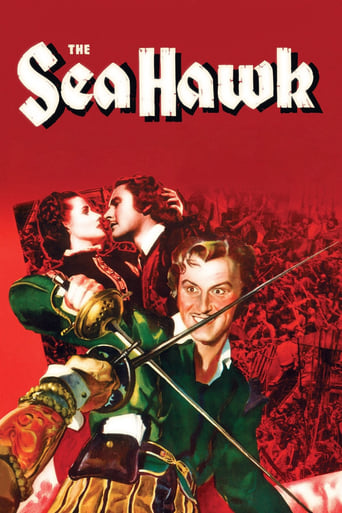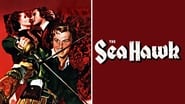Filipe Neto
This film revolves around the Invincible Armada and the attempted Spanish invasion of England during the reign of Elizabeth I. The main character is the daring Captain Thorpe, an English privateer obviously inspired by the historical figure of Sir Francis Drake. It's inevitable to look at this movie and make comparisons with "Captain Blood", a very similar film, which also speaks of piracy and also has Errol Flynn as the protagonist. Most people seem to think that "Sea Hawk" loses when compared to it, and and I agree. Brenda Marshall never establishes a credible chemistry with Flynn, her romantic partner (not to mention that Olivia de Havilland is much superior as an actress) and the plot is not very interesting nor captures public's attention. However, Flora Robson does very well as the English queen and Claude Rains is very well as the Spanish ambassador. The scenes in the sea are good, the ships are beautiful, as well as the scenarios, thought to the detail. Of course, the film has several very good fencing scenes.In summary, this film is a classic swashbuckler movie, full of humour, action and romance. It can be seen by the whole family easily and deserves a friendly place on the shelf of any good movie lover.
weezeralfalfa
When this film was made, the UK was in some danger of invasion by a planned Nazi armada of mostly small landing craft. This story concerns a previous famous threat of invasion by a powerful foreign military force: the Spanish armada of the 16th century. Speeches by the Spanish monarch at the beginning and by Queen Elizabeth at the end make clear the similar ambitions of Philip of Spain and Adolf Hitler to conquer England and the rest of Europe, then the world. Although it doesn't include the actual 16th century 'Battle of Britain', it makes clear the intention of a ferocious defense against an anticipated invasion force. The Jewish Warners were very anti-Nazi. Thus, this film might be seen as propaganda to induce the American public to support active participation by the US in WWII, before Hitler achieved his goal.Comparisons with Flynn's other two(that I am aware of) sea pirate films are in order. Whereas the prior "Captain Blood" and subsequent "Against All Flags" were scripted as taking place in the late 17th century "Golden Age of Piracy", this tale takes place about a century earlier. Here, Flynn looks like his classical self in his late 20s and 30s. As Captain Blood, 5 years earlier, he comes across more like a wild youthful rabble-rousing rebel against the English and Spanish establishments, sporting longer hair, enhancing his image as a vengeful rebel. Here, his shorter hair, along with his general demeanor, is more in keeping with a warship captain loyal to the interests of the English crown. In "Against All Flags", he again is in the service of the British Navy, never commanding his own ship, with the assignment of destroying the pirate harbor defenses in Madagascar by posing as a deserter intent on becoming a pirate. By then he looked and acted middle-aged, although he has several ferocious duels befitting a swashbuckler film. That film also differs in that it was produced by Universal, rather than Warners, Curtiz was not the director, and it was shot in gorgeous Technicolor, rather than the B&W of the 2 previous films. It is also much shorter, at only 83 min, vs. the 2 hrs. or more of the previous films.As Captain Thorpe, Flynn comes across as a modified version of Francis Drake, who led the fight to defeat the Spanish armada. This includes the invasion of Panama. The real Drake barely escaped capture by Spanish in this endeavor, whereas Thorpe and crew are taken prisoner by Spanish who have unknowingly captured their ship at anchor. For a man who had engineered all the depredations on the Spanish empire accredited to Thorpe, his sentence as a galleon slave was unbelievably generous, however necessary for the conclusion to this story.Whereas Olivia de Havilland was the only significant female character in "Captain Blood", and spitfire pirate captain Maureen O'Hara was the dominating female presence in "Against All Flags", Brenda Marshall, as demure Spanish princess Dona Maria, has to share the female spotlight with Flora Robson, as powerful Queen Elizabeth. The part was written with Olivia in mind, but she bowed out, perhaps recognizing that the role was considerably less meaty than those in "Captain Blood" or "The Adventures of Robin Hood". Dona Maria has considerably less back and forth conflict in her feelings toward and dealings with Flynn's character than Olivia's and Maureen's characters, although she is again in a conflicted political position: half English and Half Spanish. Also, Brenda lacked the natural charisma of either Olivia or Maureen, and her one song was dubbed. However, she is not completely lacking in charm or beauty."Captain Blood" packed more plot complexity into its 2 hr. than did this film or the shorter "Against All Flags", fighting not only the English aristocracy, but the Spanish and French, before accepting a surprise invitation to join the English navy and be governor of Jamaica. For me, the present film is perhaps the least interesting of the 3, even though Flynn does his most convincing, if not most flamboyant, acting job. Certainly, it was politically the most appropriate for contemporary audiences, with a rousing defiant speech at the end, worthy of Winston Churchill. Henry Daniell, as Flynn's dueling adversary, doesn't have the charisma nor rapier skill of Basil Rathbone: Flynn's rapier -dueling adversary in the previous "Captain Blood" and "The Adventures of Robin Hood". Rathbone reportedly turned down this role because it very regrettably painted the historic Lord Walsingham(renamed Wolfingham) as a Spanish spy, rather than the chief spymaster for Elizabeth that he was!This film was made, in large part, to take advantage of the expensive costumes and sets remaining from the previous year's "The Private Lives and Elizabeth and Essex". Betty Davis played Queen Elizabeth in that film. You may prefer Flora's more folksy, less face-altered, version in the present film. As some others have noted, her face and mannerisms will remind you of the later comedian Carol Burnett..... Thorpe's capuchin monkey companion serves to lighten things up from time to time.POW and convict galleon rowers are an important part of this story. However, I have been unable to confirm by drawings or words that rowers were ever used on Spanish galleons! Galleys, yes. But, not galleons. Both were included in the Spanish armada.
Martin Teller
Fun swashbuckling adventure on the high seas (and on land) with a little comedy, a little romance, some political intrigue, and lots of action. I feel like I enjoyed this more than ROBIN HOOD or CAPTAIN BLOOD, but I saw those a long time ago and maybe I've just developed more of a fondness for Errol Flynn. At any rate, he's terrific here, perfect leading man material, and his final storming of the castle is classic stuff. A lot of the other performances are kind of lackluster, but I really loved Flora Robson's sly, almost flirty portrayal of the queen. The film moves swiftly without any significant dead spots, and my interest was held throughout. Curtiz had a real gift for framing, always seeming to find a visually exciting composition. Also noteworthy is Korngold's stirring score, and a coda which does the patriotic wartime call to action better than a lot of other films of its time. If there's a weakness, it's the romance between Flynn and Brenda Marshall, which feels rather perfunctory, even though it's a significant plot element. Some people seem to have a problem with Marshall's performance, but I think she simply wasn't given enough to do.







